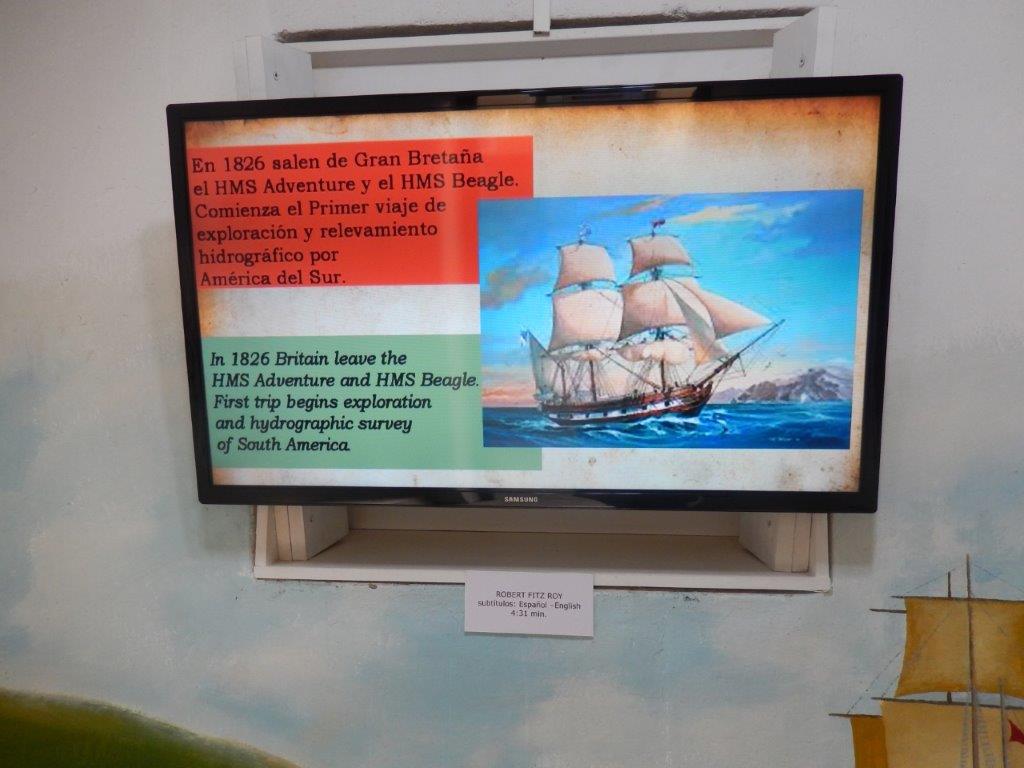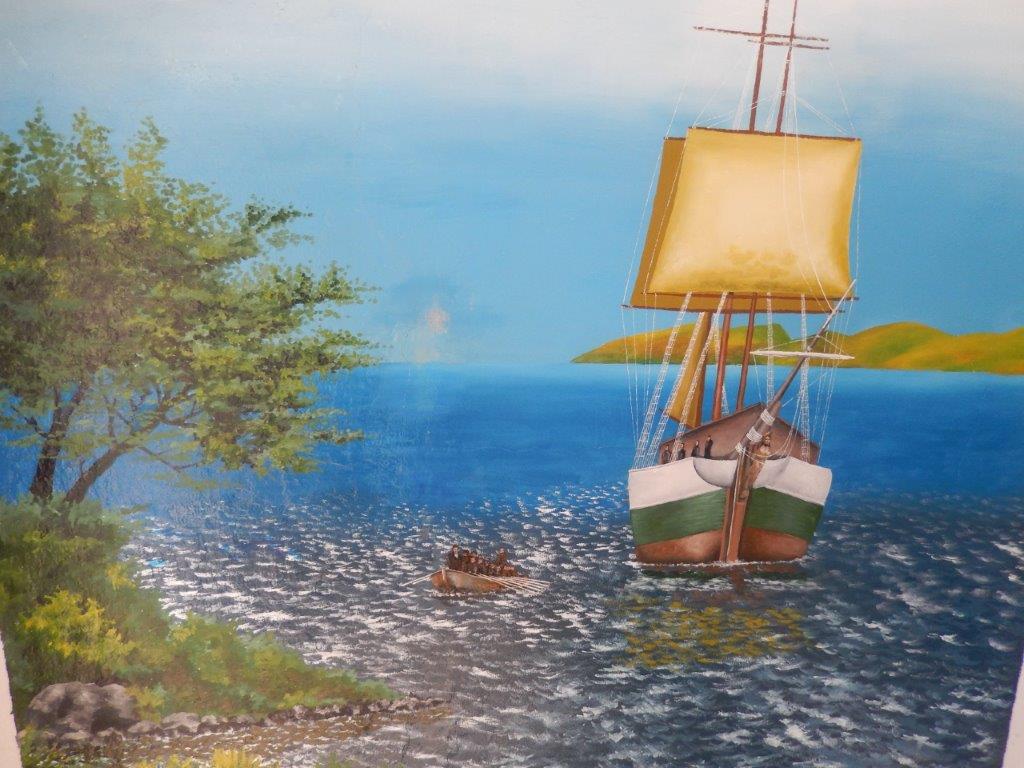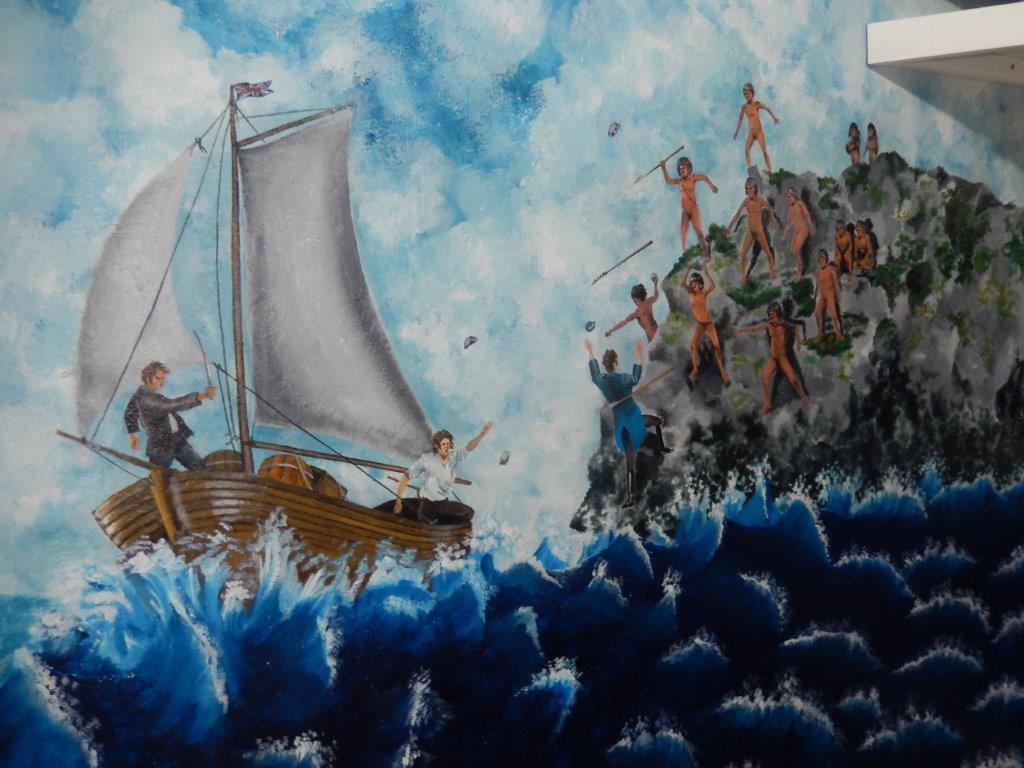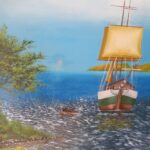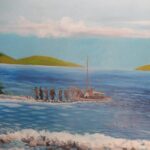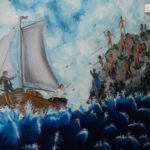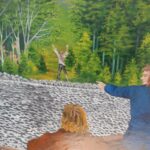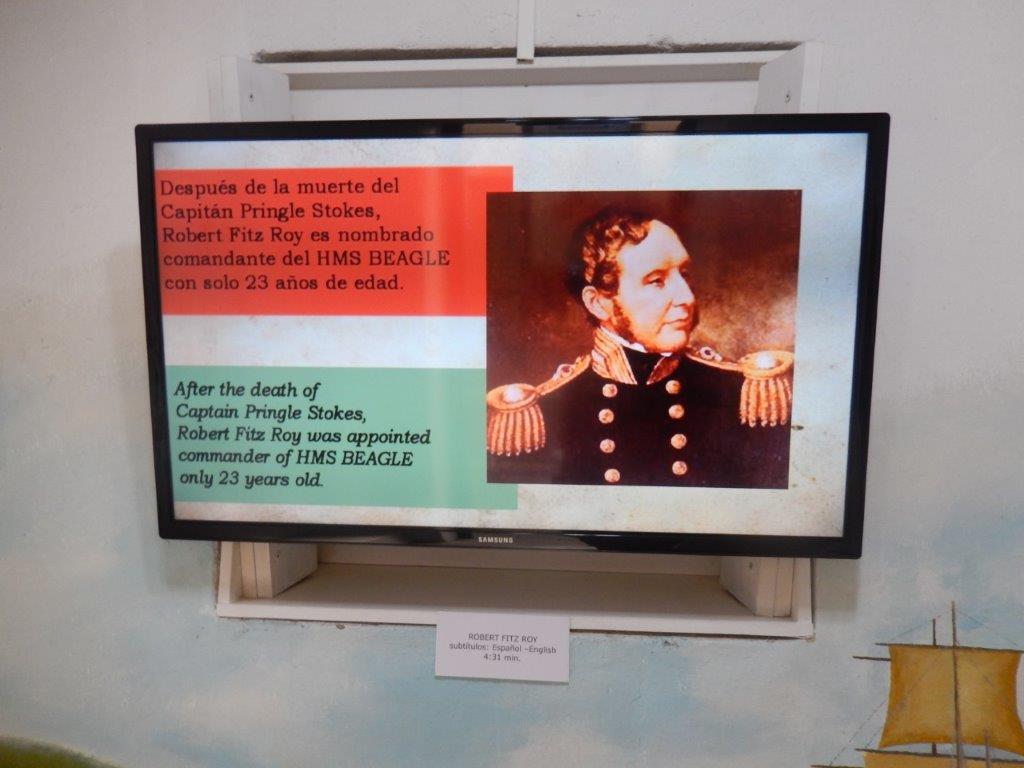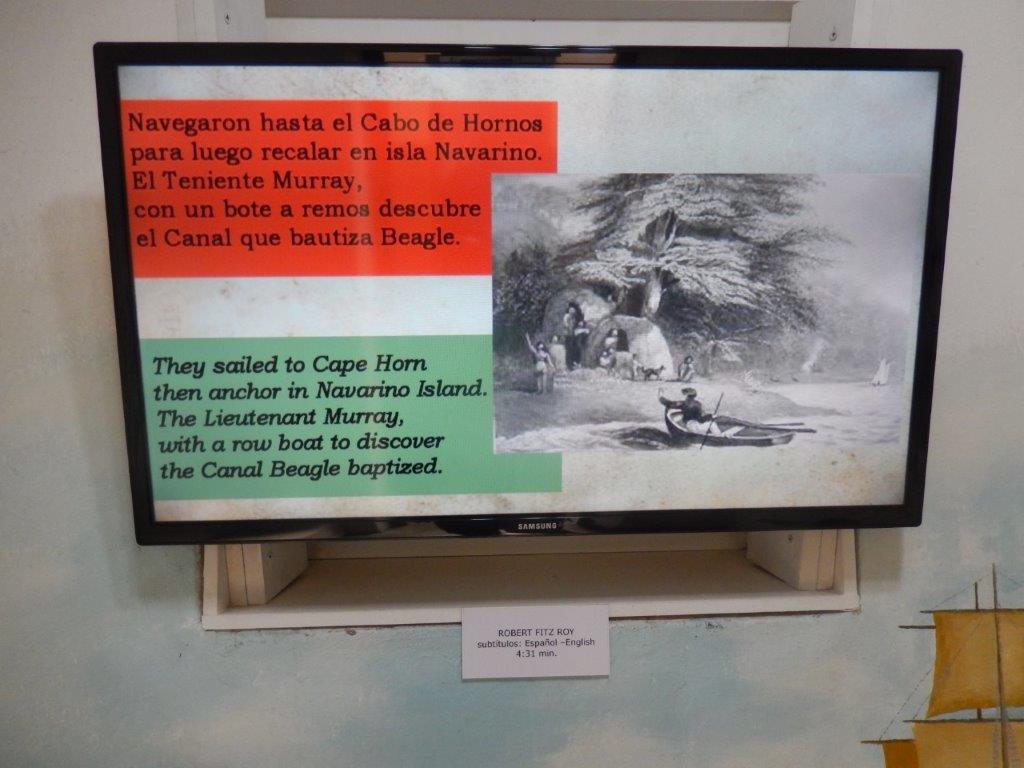42d. Argentina: Marine art museum of Ushuaia
The name Tierra del Fuego was given by the Portuguese explorer Ferdinand Magellan while sailing for the Spanish Crown in 1520; he was the first European to visit these lands. He believed he was seeing the many fires (fuego in Spanish) of the indigenous inhabitants, which were visible from the sea, and that the “Indians” were waiting in the forests to ambush his armada.
First voyage of the HMS Beagle (1826–1830)
Captain Pringle Stokes was appointed captain of Beagle on 7 September 1825, and the ship was allocated to the surveying section of the Hydrographic Office. On 27 September 1825 The Beagle docked at Woolwich to be repaired and fitted out for her new duties. Her guns were reduced from ten cannon to six and a mizzen mast was added to improve her handling, thereby changing her from a brig to a bark (or barque).
The Beagle set sail from Plymouth on 22 May 1826 on her first voyage, under the command of Captain Stokes. The mission was to accompany the larger ship HMS Adventure (380 tons) on a hydrographic survey of Patagonia and Tierra del Fuego, under the overall command of the Australian Captain Phillip Parker King, commander and surveyor.
On 3 March 1827, in the Barbara Channel, the Beagle encountered a boat with survivors of the sealer Prince of Saxe Coburg, which had wrecked in Cockburn Channel on 16 December 1826. Stokes sent two launches to rescue the other survivors who were encamped there.
During the survey, some of his men were camping onshore when a group of Fuegian natives made off with their boat. His ship gave chase and, after a scuffle, the culprits’ families were brought on board as hostages. Eventually FitzRoy held two boys, a girl and two men (one man escaped.) As it was not possible to put them ashore conveniently, he decided to “civilise the savages”, teaching them “English … the plainer truths of Christianity … and the use of common tools” before returning them as missionaries.
The sailors gave them names: the girl was called Fuegia Basket (so named because the replacement for the stolen boat was an improvised coracle that resembled a basket), the younger boy Jemmy Button (FitzRoy allegedly ‘purchased’ him with a large pearl button), the man York Minster (after the large rock so-named near which he was captured). The second, elder, boy he named Boat Memory. FitzRoy brought the four back with the ship to England. Boat Memory died following a smallpox vaccination. The others were cared for and taught by the trainee missionary Richard Matthews; they were considered civilised enough to be presented at Court to King William IV and Queen Adelaide in the summer of 1831.
Faced with the more difficult part of the survey in the desolate waters of Tierra del Fuego, Captain Stokes fell into a deep depression. At Port Famine on the Strait of Magellan, he locked himself in his cabin for 14 days, then after getting over-excited and talking of preparing for the next cruise, shot himself on 2 August 1828. Following four days of delirium, Stokes recovered slightly, but then his condition deteriorated and he died on 12 August 1828. Captain Parker King then replaced Stokes with the First Lieutenant of Beagle, Lieutenant William George Skyring as commander, and both ships sailed to Montevideo. On 13 October, King sailed Adventure to Rio de Janeiro for refitting and provisions. During this work Rear Admiral Sir Robert Otway, commander in chief of the South American station, arrived aboard HMS Ganges and announced his decision that Beagle was also to be brought to Montevideo for repairs, and that he intended to supersede Skyring. When Beagle arrived, Otway put the ship under the command of his aide, Flag Lieutenant Robert FitzRoy.
During this survey, the Beagle Channel was identified and named after the ship.
The log book from the first voyage, in Captain FitzRoy’s handwriting, was acquired at auction at Sotheby’s by the Museo Naval de la Nación (under the administration of the Argentine Navy) located in Tigre, Buenos Aires Province, Argentina, where it is now preserved.
Second voyage (1831–1836)
They returned to Tierra del Fuego in the Beagle with FitzRoy and Charles Darwin, who made extensive notes about his visit to the islands.
They reached Tierra del Fuego on 18 December 1832, and Darwin was taken by surprise at what he perceived as the crude savagery of the Yaghan natives, in stark contrast to the “civilised” behaviour of the three Fuegians they were returning as missionaries (who had been given the names York Minster, Fuegia Basket and Jemmy Button). He described his first meeting with the native Fuegians as being “without exception the most curious and interesting spectacle I ever beheld: I could not have believed how wide was the difference between savage and civilised man: it is greater than between a wild and domesticated animal, inasmuch as in man there is a greater power of improvement.” They appeared like “the representations of Devils on the Stage” as in Der Freischütz. In contrast, he said of Jemmy that “It seems yet wonderful to me, when I think over all his many good qualities, that he should have been of the same race, and doubtless partaken of the same character, with the miserable, degraded savages whom we first met here.” (Four decades later, he recalled these impressions in The Descent of Man to support his argument that just as humans had descended from “a lower form”, civilised society had arisen by graduations from a more primitive state. He recalled how closely the Fuegians on board Beagle “resembled us in disposition and in most of our mental faculties.”)
At the island of “Buttons Land” on 23 January 1833, they set up a mission post with huts, gardens, furniture and crockery. Upon returning nine days later, the possessions had been looted and divided up equally by the natives. Matthews gave up, rejoining the ship and leaving the three civilised Fuegians to continue the missionary work. Beagle went on to the Falkland Islands, arriving just after the British return. Darwin studied the relationships of species to habitats and found ancient fossils like those he found in Wales. FitzRoy bought a schooner to assist with the surveying, and they returned to Patagonia, where it was fitted with a new copper bottom and renamed Adventure. Syms Covington assisted Darwin in preserving specimens, and his collecting was so successful that, with FitzRoy’s agreement, he hired Covington as a full-time servant for £30 a year.
 Darwin had kept a diary of his experiences, and combined this with details from his scientific notes as the book titled Journal and Remarks, published in 1839 as the third volume of the official account of the expedition. This travelogue and scientific journal was widely popular, and was reprinted many times with various titles and a revised second edition, becoming known as The Voyage of the Beagle. Darwin 1989, pp. 2–3, 24.
Darwin had kept a diary of his experiences, and combined this with details from his scientific notes as the book titled Journal and Remarks, published in 1839 as the third volume of the official account of the expedition. This travelogue and scientific journal was widely popular, and was reprinted many times with various titles and a revised second edition, becoming known as The Voyage of the Beagle. Darwin 1989, pp. 2–3, 24.
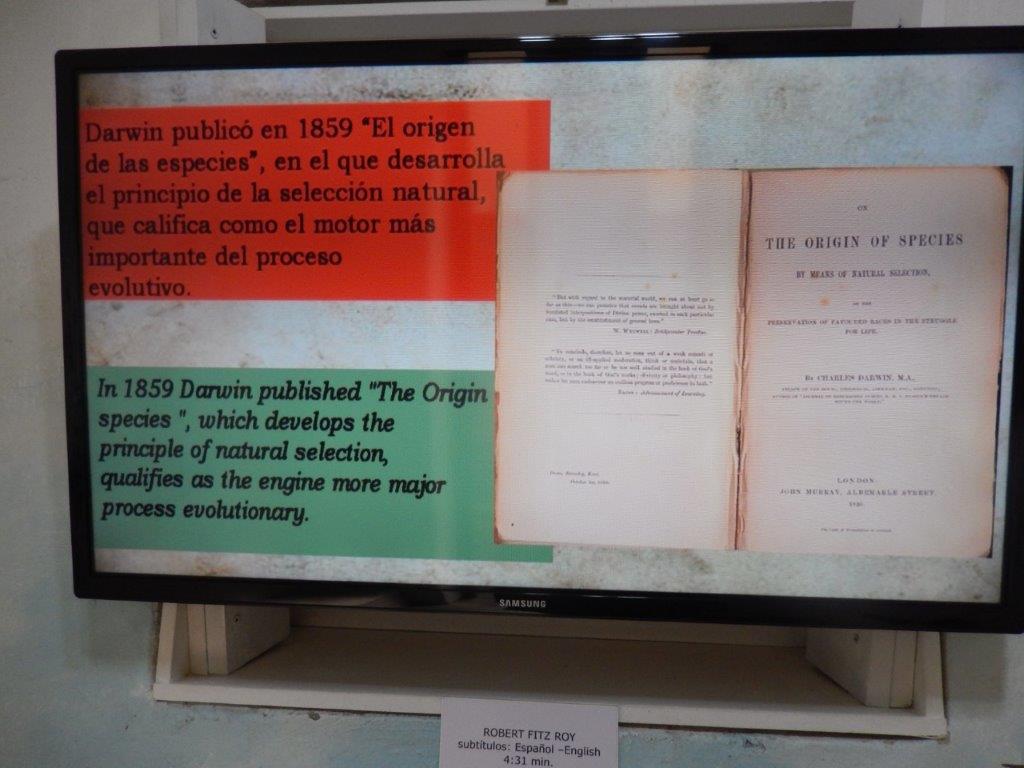 This blogpost concludes my series of museum posts. I simply loved this museum, containing a wealth of knowledge of this part of the world.
This blogpost concludes my series of museum posts. I simply loved this museum, containing a wealth of knowledge of this part of the world.
Go and visit it when visiting Ushuaia.

